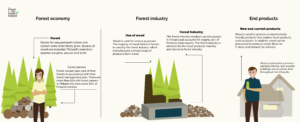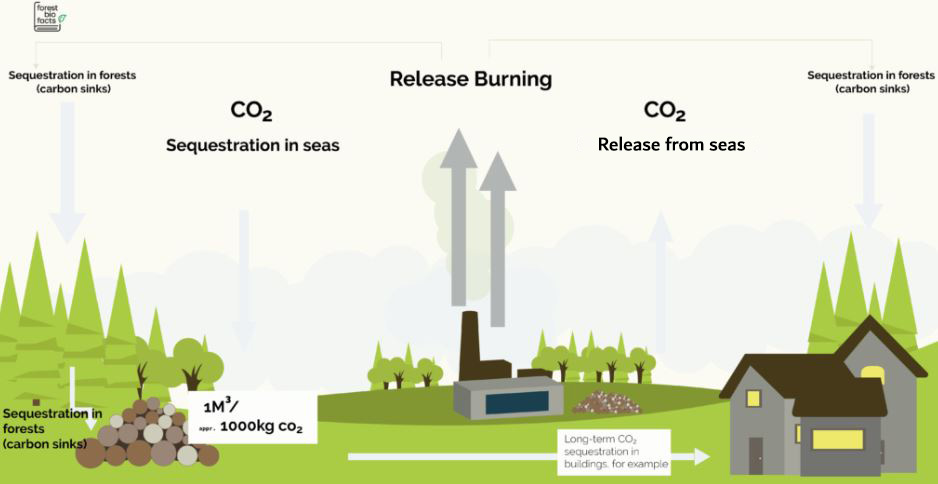The bioeconomy is humankind’s greatest opportunity
The sustainable use of forests plays a central part when people are developing more ecologically, financially and socially sustainable practices. This is necessary, especially as the plentiful and growing use of fossil fuels has led to significantly elevated carbon dioxide levels in the atmosphere and to climate change. The growing global population of nearly eight billion is awakening up to the reality of Earth’s limited resources. It is time to change the direction more forcefully toward circular economy – for this, ForestBioFacts offers a valuable knowledge base.
Forests and forest-based industries comprise an essential part of a sustainable bioeconomy. Watch why!
“Trees can replace fossil material and sequester carbon”, says Heikki Hassi, D.Sc. (Tech.), from SciTech-Service.
The significant role of forests
Humankind is facing possibly the greatest challenge in history – climate change. Now, we are urgently looking for sustainable ways to satisfy our needs while also achieving better harmony with the nature. Here, forests play an important part: forest ecosystem goods and services offer solutions for fulfilling modern human needs and desires. Forest based industries, forestry and the many services used by them form the forest-based bioeconomy.
Wood, the main raw material of the forest bioeconomy, is a lasting, durable, ecological and fairly rapidly renewable raw material, which is available in abundance, especially in boreal, subtropical and tropical zones. Thanks to its versatile structure and composition, wood suits well to different conversion processes and hence in construction and packaging, for example, it replaces products which cause considerably higher emissions and lifecycle impact, such as plastic, cement and steel 1. Pulp, a wood-based raw material for paper and board, is also an ecological material for replacing synthetic fibres and cotton in the textile industry. Read more about the products in the Wood can be turned into a variety of products article.
From a fossil economy towards a sustainable bioeconomy

employs a total of 140 000 people in Finland.
Fossil fuels, such as coal and oil, have been a prerequisite for the rise of the global standard of living. Low-cost fossil energy has been available in abundance from the early industrial age in the 1800s to this day. Combustion has been the most common way to generate energy – be it heating, transport or in mega-sized factories. Carbon dioxide released when combusting fossil fuels has, however, become a global problem, as it is raising temperatures everywhere. This is called climate change, accelerated primarily by the increased amount of carbon dioxide (CO2) in the atmosphere.
No single clean technology to control climate change or no single clean raw material to replace coal and oil exists on a global scale. Instead, a low-carbon production and consumption system needs to be built using many different technologies, models and processes.
Forest-based energy
Replacing emissions from the burning and processing of fossil fuels in the energy sector using sustainable solutions and renewable resources is important, as the sector makes up 72 % of the world’s greenhouse gas emissions 2. Biomasses from forestry and agriculture can partially replace fossil energy sources and nudge heating and transport towards a low-emission future, for example.
In Finland, 20 % of the total energy consumption is covered by wood-based fuels whose components include bark, sawdust, forest industry sludge and wood residues 3. Furthermore, transport fuels available to consumers in Finland, such as petrol and diesel, contain biofuels, with the renewable distribution obligation being at least 20 %. Biofuel can be made from practically any renewable raw material, while it cannot compete with food production resources to any significant extent 4.
However, it is not useful for the climate to use forest energy to replace fossil fuels on a large scale. Increased felling in slowly growing forests, such as Finland’s forests, for energy generation purposes would not produce any significant climate benefits in the short or medium term compared with fossil fuels. The reason is that wood used as energy only sequesters carbon for a short period and a felled forest grows slowly back into a carbon sink. However, it is useful for the climate to produce forest energy from rapidly renewable wood and especially by using logging residues, such as branches and trees felled at thinning sites as raw material for biofuels 2. In addition, side streams from industrial sectors that use wood should be used as bioenergy.
The role of forests in the bioeconomy
The ever growing population is stretching the limits of the Earth’s carrying capacity. According to the UN’s World Population Prospects, the global population will grow from the current 7.9 billion by up to two billion by 2050 5. At the same time, the standard of living will rise in significant population centres, such as China and India. As a result of these factors, urban areas will spread and food consumption will increase. To satisfy the needs of the growing population, forests need to be cleared to increase the field area for food production and to build more cities. This is why the world’s forest area is currently decreasing by 0.2 %, or seven million hectares, per year 6. Deforestation is estimated to account for roughly 10 % of human-induced greenhouse gas emissions 1.
The use of forests
In addition to producing bioproducts and bio-based raw materials, another central role of the forest bioeconomy is to act as global carbon stocks and carbon sinks, sequestering carbon from the atmosphere. Wood as an organism effectively sequesters carbon dioxide from the atmosphere through photosynthesis, and growing forests act as carbon sinks and carbon stocks for sequestered carbon. Forests cover 30 % of the Earth’s surface, with their area totalling 39 million square kilometres,7 being home to 430 billion cubic metres of growing roundwood. As forests provide people with nature’s vital ecosystem services, we need to use them sustainably. We also need to consider any changes in the size of forest carbon stocks and carbon sinks, as well as biodiversity. Sustainable forestry and the sustainable use of forests consist of financial, ecological and social elements, and their coordination forms the basis of sustainable forestry 8.
Forests can be used forever as long as they are tended and used wisely. Sustainable forestry addresses both the processing and the protection of forests. Watch the video to see more!
Sustainable forestry – properly tended forests grow while sequestering carbon dioxide
Growing forests are carbon sinks that absorb carbon dioxide from the atmosphere. The size of a carbon sink is based on tree growth and greenhouse gas emissions. Information about tree growth can be obtained from the National Forest Inventory and roundwood removal statistics 9. When roundwood removals are deducted from tree growth and converted into carbon dioxide, the carbon balance can be calculated. The carbon balance indicates changes in the amount of carbon sequestered in forests during a specific period, such as per year 10. The growing season of trees is short in Finland, normally from the end of May until the beginning of August. During this period, trees absorb carbon dioxide from the atmosphere. For example, a one-hectare pine forest sequesters 9.5 tons of carbon dioxide during a single growing season 11.

Finland’s massive forest resources
As a result of decades of proper tending, Finland’s forest resources have grown considerably. Primary reasons for this increase in forest resources include active silviculture, the forestation of new areas and the development of silvicultural methods. Growing forest resources have naturally also increased forest carbon sinks. As a young rapidly growing forest sequesters carbon dioxide more effectively than an old forest with slower growth, the younger age structure of trees 12 has contributed to the increase in Finland’s forest carbon sinks 13. Finland’s forests are growing by more than 100 million cubic metres per year, and the size of the net carbon sink on forest land is roughly 27 million tons 14.
Forest certification ensures sustainability
In Finland, we are taking good care of our forests and broadly fulfilling the principles of sustainable silviculture, as is indicated by the many forest certificates granted for Finland’s forests. Up to 95 % of Finland’s forests are covered by the PEFC or FSC certification 15. Certification ensures that the management and use of forests meet the financial, social and ecological requirements set for sustainable forestry. The ecological requirements of the certification systems are concretely visible by means of silvicultural activities, such as retention and decayed trees left at clearcutting sites, buffer strips close to watercourses and the protection of valuable habitats.
The ecologically sustainable use of forests therefore protects the wellbeing of forests and maintains biodiversity, guaranteeing a living environment for more than 20 000 species living in our forests. More and more attention is being paid to the protection of biodiversity in forestry. This can be seen, for example, through the high number of forest certificates granted, national forest conservation projects and the increase in research data about forests.
In 2019, a total of 72 million cubic metres of roundwood were felled from these well-tended forests 11, with total roundwood removals being 87 million cubic metres in accordance with the most recent statistics of the Natural Resources Institute Finland (Luke) 16. This means that annual forest growth is higher than roundwood removals through felling and natural tree mortality. According to Luke’s estimates, the maximum sustainable yield of Finnish forests between 2016 and 2025 is 80.5 million cubic metres per year on average 10. This can be regarded as the basis of sustainable forestry.
Active silviculture
Forests form a significant asset item for Finnish people, with 60 % of Finland’s forests being under private ownership 17. Similarly to other assets, people take good care of their forests, and they carry a high financial value. Forests are also important in the protection and management of biodiversity, and they offer recreation for people who enjoy nature. Silvicultural models aim not only to increase the financial value, but also to maintain biodiversity in forests and offer recreation to outdoor enthusiasts. In Finland, minimum requirements for the management and use of forests are set out in the Forest Act 18.
Silvicultural models
Pine and spruce, Finland’s two most common coniferous tree species, and birch, the most common deciduous tree species, reach their full height and diameter in 50 to 90 years. An evenly aged forest where tree growth has slowed down due to aging should be regenerated. In practice, forest regeneration means that aged trees are felled and new trees are grown. New tree growth is started naturally by mother trees left at the felling site or by taking active measures, such as planting saplings or seeds of a selected tree species. 19 Some 1 500 to 2 500 saplings are planted per hectare, depending on the tree species.
Continuous cover forestry
The model of continuous cover forestry is becoming more common alongside the conventional periodic even-aged forestry based on regeneration felling. In this silvicultural model, trees of different ages grow simultaneously in a forest, only some of which are felled at a time, typically by means of gap felling or selection cutting. Advantages of continuous cover forestry compared with the conventional periodic even-aged forestry include the distribution of income obtained from forests over shorter periods and lower silvicultural costs. In terms of wood production, continuous cover forestry does not, however, reach the output of even-aged forestry. As a result of lower silvicultural costs, its financial profitability may, nevertheless, be higher. 20 Continuous cover forestry is better suited than even-aged forestry in certain locations. In peatlands, for example, it improves the ecological sustainability of forestry by reducing the need for remedial ditching 21. Benefits of continuous cover forestry in terms of finances, carbon sequestration and the maintenance of biodiversity are being investigated.
Monitoring growth
Growth of planted, seeded or naturally regenerating commercial forests are monitored throughout their lifecycles. Forest owners tend growing forests in accordance with a forest management plan. Tending regularly includes early and later pre-commercial thinning, forest thinning and fertilisation. During thinning, healthy and rapidly growing trees of a high quality are left to grow. Thinning also aims to ensure the sufficiency of key resources for tree growth, such as light and nutrients, for the trees left to grow. In even-aged forestry, the frequency of thinning varies during the tree growth cycle from two to three thinning times, depending on the tree species, silvicultural model and location.
